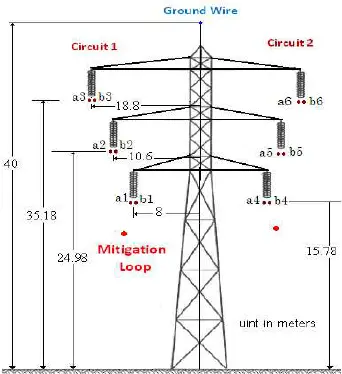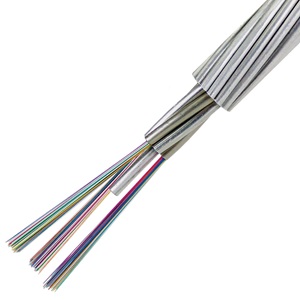What is OPGW?
OPGW (Optical Ground Wire ) is made up of two components Optical fiber and earth wire. In new transmission lines it is being installed in place of conventional ground wire and in old lines also earth wire is being replaced with OPGW due to its many advantages over ground wire. Ground wire is installed in the top most part of transmission towers as its main purpose is to shield the conductors from lightning and as this wire grounds the current which is produced due to thundering in rainy season.

While the conventional earth wire can only shield the conductors from lightning ,OPGW cable on the other hand performs two functions ,one that of grounding and other of communication and protection. This cable contains a tubular structure with one or more optical fibers in it, and this is surrounded by layers of steel and aluminum wire.

The optical fibers within this cable can be used for high-speed transmission of data, speech and protection and control of the transmission line, or the fibers can be leased or sold to third parties to serve as a high-speed fiber interconnection between cities which can be used for broadband internet connection. For protection of lines through OPGW, we use Digital Protection Coupler (DTPC) for tripping of lines.
Overview of OPGW cable construction:
- Core Components:
- Optical Fibers: These cables contain optical fibers for data transmission. These fibers are typically made of glass or plastic and are carefully arranged within the cable structure.
- Metallic Grounding Wires: Surrounding the optical fibers are one or more layers of metallic wires, usually made of aluminum or a combination of aluminum and steel. These wires serve as the grounding component for electrical purposes.
- Central Tube or Stranded Design:
- These cables may have a central tube or a stranded design. In a central tube design, optical fibers are placed in a central tube surrounded by metallic wires. In a stranded design, optical fibers and metallic wires are intertwined throughout the cable structure.
- Layering and Insulation:
- Layers of materials, such as tapes or yarns, may be added to provide insulation and protection for the optical fibers and grounding wires.
- The cable may also include a layer of water-blocking material to prevent water ingress and enhance durability.
- Armoring (Optional):
- Some OPGW cables may feature an additional layer of armor, typically made of aluminum or steel, for increased mechanical protection. This armoring enhances the cable’s resistance to environmental factors and physical damage.
- Outer Sheath:
- The entire cable assembly is enclosed in an outer sheath, usually made of polyethylene or another suitable material. The outer sheath provides additional protection against moisture, UV radiation, and external elements.
- Marking and Identification:
- OPGW cables are often marked with information such as the manufacturer’s name, cable type, fiber count, and other relevant details for identification and maintenance purposes.
- Testing:
- Quality control measures include testing the optical and electrical performance of the cable. This ensures that the cable meets industry standards and specifications.
- Reel Packaging:
- After construction and testing, OPGW cables are typically wound onto large reels for transportation and installation.
- Installation:
- During installation, the OPGW cable is carefully strung along the transmission line route, attached to transmission towers or utility poles.
- Commissioning:
- Once installed, the OPGW cable undergoes commissioning, including testing to verify its proper functioning and adherence to design specifications.
OPGW Applications
PLCC (Power line carrier communication) is used in transmission line for Data, Speech and Protection of lines between two substations where conventional Ground wire is used ,but this technology is becoming old due to introduction of OPGW . OPGW with Digital protection coupler can perform all functions of earlier PLCC like transfer of data, Protection and Speech.
The optical fibers embedded within OPGW enable high-speed data transmission over long distances, making it ideal for connecting remote areas and facilitating internet access in underserved regions. Telecom operators leverage OPGW to expand their network coverage and deliver reliable communication services.
Digital Protection Coupler
Digital protection coupler is a critical component in modern electrical systems, playing a vital role in safeguarding equipment and ensuring reliable operation. A digital protection coupler serves as an interface between protective relays and communication networks, enabling seamless communication and coordination of protection functions.
Digital protection couplers act as communication gateways, translating analog signals from protective relays into digital data for transmission over communication networks. They ensure accurate and reliable exchange of protection-related information, including fault currents, voltage levels, and trip signals.
Digital protection couplers facilitate coordination and synchronization of protective relays across multiple substations. By exchanging synchronized time-stamped data, they enhance the speed and accuracy of fault detection and isolation, improving overall system reliability.
FAQs
- What does OPGW stand for?
OPGW stands for Optical Ground Wire, a specialized cable used in power transmission and telecommunication systems. - How is OPGW different from traditional ground wires?
Unlike traditional ground wires, this cable incorporates optical fibers for data transmission alongside metallic wires for power transmission, offering dual functionality. - Can these cables be installed on existing power transmission lines?
Yes, OPGW can be retrofitted onto existing power transmission lines with proper installation techniques and equipment. - What are the key considerations for selecting OPGW for a project?
Key considerations include project requirements, environmental conditions, budget constraints, and compatibility with existing infrastructure. - Is OPGW compatible with different weather conditions?
Yes, the cables are designed to withstand various weather conditions, including high winds, ice, and extreme temperatures, ensuring reliable performance year-round